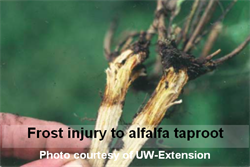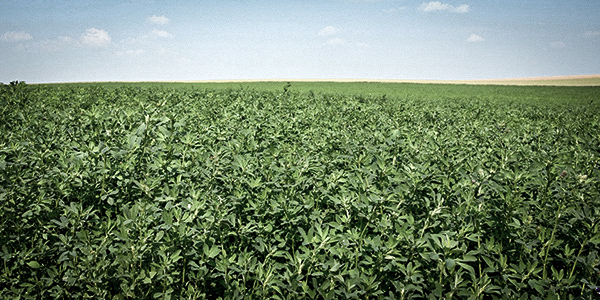AGRONOMICSUPPORT
YOU CAN TAKETO THE FIELD
Evaluating Alfalfa Stands
This past winter has been anything but gentle on the alfalfa currently out in the fields. Across the Midwest alfalfa dealt with periods of extreme cold temperatures, ice sheets and heaving. How will the plants deal with these situations? Only time will tell, but we need to know how to evaluate once spring finally arrives.
One cause of winter injury are extreme temperatures. An alfalfa plant can tolerate temperatures as low as 5 to 15oF. When a cell gets exposed to colder temperatures, the water in the cell freezes causing the cell wall to puncture. When temperatures warm back up, all the content in the cell leaks out and the cell dies. Ice sheeting is another cause of winter kill. When a sheet of ice covers alfalfa and doesn’t allow air to the crown, toxic metabolites build up and kill the plant.
There are a few ways to identify injured and/or killed alfalfa. First, look at the roots. Dig a plant out in the spring and split the crown in half with a knife. Are the crown and roots white and firm? If injured, the crown and roots will be spongy, yellowish to dark brown and dehydrated looking. If a field is turning green when you begin to evaluate, look for areas of the field that remain brown. Uneven growth will also occur when the crown buds are slightly damaged. Surviving buds will begin to grow and the plant will grow new crown buds.
plant out in the spring and split the crown in half with a knife. Are the crown and roots white and firm? If injured, the crown and roots will be spongy, yellowish to dark brown and dehydrated looking. If a field is turning green when you begin to evaluate, look for areas of the field that remain brown. Uneven growth will also occur when the crown buds are slightly damaged. Surviving buds will begin to grow and the plant will grow new crown buds.
How do you know if the damaged areas are large enough to be concerned? If stem counts are greater than 55 stems/ft2, yield should not be affected. Between 40-55 stems/ft2 indicates you will have a yield reduction. Then, you will have to decide if that field’s yields are needed for this year’s inventory. If so, you may leave for this year, then terminate. Fewer than 40 stems/ft2 indicates a poor stand and termination should be considered. If the field is only spotty in damage, annual ryegrass and perennial ryegrass can be inter-seeded to help with forage and to extend life of the stand.
.png?sfvrsn=98d0f258_0&MaxWidth=500&MaxHeight=&ScaleUp=false&Quality=High&Method=ResizeFitToAreaArguments&Signature=9891BEB9627658231A320ADCDAA4F9F1B6D4D016) An alfalfa stand can be slow to recover, so make sure you evaluate properly. If stem counts are in the 40-55 stems/ft2, you should probably get everything you can get out of the stand for one last year, then terminate. If the stand is spotty, inter-seeding should be considered to stretch the life of the stand. If the alfalfa is injured, let the stand mature slightly longer, and then cut with an increased height. This will give the damaged alfalfa the best chance to recover fully.
An alfalfa stand can be slow to recover, so make sure you evaluate properly. If stem counts are in the 40-55 stems/ft2, you should probably get everything you can get out of the stand for one last year, then terminate. If the stand is spotty, inter-seeding should be considered to stretch the life of the stand. If the alfalfa is injured, let the stand mature slightly longer, and then cut with an increased height. This will give the damaged alfalfa the best chance to recover fully.
Sources and additional information:
https://fyi.extension.wisc.edu/forage/evaluating-and-managing-alfalfa-stands-for-winter-injury/
https://fyi.extension.wisc.edu/forage/alfalfa-stand-assessment-is-this-stand-good-enough-to-keep/
Download a copy of this technical bulletin here: Evaluating Alflfa Stands






Technical Team Agronomist